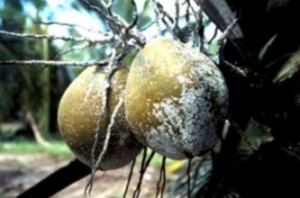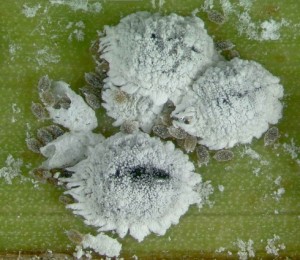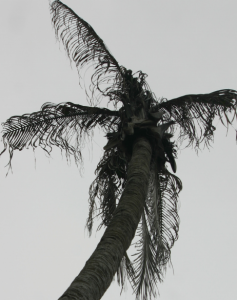 In Sanskrit, coconut trees are referred to as “Kalpa Vriksha” which means, “The tree that gives all that is necessary for life.” This is no exaggeration because they have been an important source of food, clothing, and shelter since time immemorial. However, our beloved coconut tree is fighting for its own life, and along with it, the lives of thousands of people whose livelihood depends on it. Cocolisap (Aspidiotus destructor rigidus) is a small plant parasite that may cause the demise of our trees, if not given proper cure and care. Based on a report by The Bureau of Agricultural Statistics, around 2.1 million coconut trees are now in various stages of infestation by this pest!
In Sanskrit, coconut trees are referred to as “Kalpa Vriksha” which means, “The tree that gives all that is necessary for life.” This is no exaggeration because they have been an important source of food, clothing, and shelter since time immemorial. However, our beloved coconut tree is fighting for its own life, and along with it, the lives of thousands of people whose livelihood depends on it. Cocolisap (Aspidiotus destructor rigidus) is a small plant parasite that may cause the demise of our trees, if not given proper cure and care. Based on a report by The Bureau of Agricultural Statistics, around 2.1 million coconut trees are now in various stages of infestation by this pest!
Cocolisap feeds on the leaves of young palms and on the surface of fruits that result in the yellowing and wilting of leaves, till the entire coconut tree dies. It prevents photosynthesis, causing premature nut fall and low productivity. The cocolisap attacks the coconut tree by eating the leaves, fruits, and flowers until only the trunk is left. The insect feeds on the sap of the tree and injects toxic enzymes, resulting in discolored leaves and deformed plant tissues that retard the growth of the coconut tree. By this time, the tree is beyond resuscitation, and would be worth only the salvaged coco-lumber. Wind or the transport of infested coconuts can spread cocolisap. Although coconut is the preferred host, cocolisap also attacks fruit trees such as mangosteen, lanzones, etc.
 Since 2010, when the first signs of infestation by coconut scale insects or cocolisap appeared, nothing much had been achieved to control the spread of the destructive pest. Recently, the government acknowledged the severity of the problem when it declared a state of calamity in the Calabarzon (Cavite, Laguna, Batangas, Rizal, and Quezon) zone and Basilan. Approximately one million trees are said to be at risk valued at $ 760 million! The Bureau of Agricultural Statistics (BAS) reports that annual production of coconut dropped by 3.3 % – from 15.86 million MT in 2012 to 15.34 million MT last year. The local coconut industry has already lost at least $ 4.6 million because of the massive infestation and the losses are mounting as each day passes. By mid-2014, the cocolisap situation reached outbreak proportions affecting more than 60% of the total coconut production in affected areas!
Since 2010, when the first signs of infestation by coconut scale insects or cocolisap appeared, nothing much had been achieved to control the spread of the destructive pest. Recently, the government acknowledged the severity of the problem when it declared a state of calamity in the Calabarzon (Cavite, Laguna, Batangas, Rizal, and Quezon) zone and Basilan. Approximately one million trees are said to be at risk valued at $ 760 million! The Bureau of Agricultural Statistics (BAS) reports that annual production of coconut dropped by 3.3 % – from 15.86 million MT in 2012 to 15.34 million MT last year. The local coconut industry has already lost at least $ 4.6 million because of the massive infestation and the losses are mounting as each day passes. By mid-2014, the cocolisap situation reached outbreak proportions affecting more than 60% of the total coconut production in affected areas!
This issue can be better understood by reading the following article,
Cocolisap damage in Basilan reaches P18M
June 16, 2014
By Noel Tarrazona
ZAMBOANGA CITY: Close to 1,000 coconut farmer owners and workers in Isabela City in Basilan have suffered income losses after 107,356 coconut trees and coconut seedlings were reportedly damaged caused by cocolisap, a swarm of coconut scale insects that often attack coconut trees during dry spell period.
Philippine Coconut Authority (PCA) Provincial Development Manager Efren Carba told The Manila Times that the damage cost of different plantations have already reached an estimate of P 18 million and if left unattended this will certainly have an adverse economic effect not only to the coconut farm stakeholders but also those workers in the oil milling industry.
Carba said his office also received reports that other trees like lansones, banana and papaya were also affected by the swarm of scale pests in Isabela.
PCA earlier requested its research office from Davao to address the growing damage in Basilan and a team introduced bio control measures like the introduction of parasite beetles which can terminate the pests by eating them. The bio control seems to be of little effect since more coconut trees were reportedly damaged.
Carba further recommended the continuous pruning and burning of infested parts of coconut trees to minimize the extent of damage.
In Zamboanga City, particularly in Barangay Sinunuc, a group of farmers reported yellowish coconut trees that were showing symptoms of the presence of scale insect pests. Carba immediately sent a team of specialists to the area but reported a false alarm. The yellowish symptoms of coconut were caused by worm-insects which are more manageable and less destructive.
Carba further appealed to the Quarantine Office of the Department of Agriculture in Zamboanga to quarantine all coco products coming from Basilan and these include coco seedling and coconut shells.
“We should be watchful and vigilant so these pests will not infest our coconut trees here in Zamboanga,” Carba added.
The PCA reported that 18 villages have already confirmed the presence of these scale pests in Isabela City in Basilan. Isabela has 45 barangays and 33 of these barangays are with huge coconut plantations.
 The Philippines has about 3.5 million coconut farmers and 26% of the total agricultural land is devoted to coconut farming alone! This highlights the severity of the situation and the need to find a solution for the problem before this pest threatens to wipe out our coconut trees. Until now, quick and toxic methods had been used to combat cocolisap infestation. However, the conventional method that includes spraying and injecting the coconut trunk with neonicotinoids, have proven to be lethal to the environment and the people. Thus, we are in dire need of a solution that helps protect the coconut trees from damage, while at the same time does not harm the environment in any way.
The Philippines has about 3.5 million coconut farmers and 26% of the total agricultural land is devoted to coconut farming alone! This highlights the severity of the situation and the need to find a solution for the problem before this pest threatens to wipe out our coconut trees. Until now, quick and toxic methods had been used to combat cocolisap infestation. However, the conventional method that includes spraying and injecting the coconut trunk with neonicotinoids, have proven to be lethal to the environment and the people. Thus, we are in dire need of a solution that helps protect the coconut trees from damage, while at the same time does not harm the environment in any way.
So for this particular problem, we at C Tech Corporation have come up with a viable solution.
At C Tech Corporation, we offer a safe and effective solution to deal with these insects.
Combirepel™ is a non-hazardous product that primarily repels insects from the application. It is a broad spectrum repellent which works against insects thus efficaciously repulse them away from the application. The best feature of this product is that it is environmentally safe and causes no harm to the insect as well as humans and the environment.
The product available in the form of lacquer can be used as a topical application and can be applied to wooden and concrete structures of heritage sites. The liquid concentrate is compatible with most of the surfaces like wood, concrete, fiber, ceramic, metal, polymer etc.
The product available in the form of masterbatch can be incorporated into polymeric applications like wires and cables, pipes, agricultural films, etc. while they are manufactured. The product will prevent the ladybugs from coming near to these applications.
The liquid concentrate can be mixed with paints in a pre-determined ratio and be applied to the interior and exterior areas of heritage sites which can be painted. The liquid concentrate is compatible with all types of paints and solvents.
Using our products, they can repel the termites in an eco-friendly way!
Contact us at technical.marketing@ctechcorporation.com if you are facing problems with insects.
Also, visit our websites:
http://www.ctechcorporation.com/
http://www.rodrepel.com/
http://www.termirepel.com/
http://www.combirepel.com/
Follow our Facebook pages at:
1] https://www.facebook.com/Combirepel-411710912249274/
2] https://www.facebook.com/Termirepel-104225413091251/
3] https://www.facebook.com/Rodrepel-120734974768048/
Follow us on our Twitter pages at:
1] https://twitter.com/rodrepel
2] https://twitter.com/termirepel
3] https://twitter.com/combirepel
